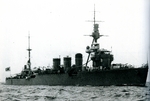Kitakami
| Country | Japan |
| Ship Class | Kuma-class Light Cruiser |
| Builder | Sasebo Naval Arsenal |
| Laid Down | 1 Sep 1919 |
| Launched | 3 Jul 1920 |
| Commissioned | 15 Apr 1921 |
| Decommissioned | 30 Nov 1945 |
| Displacement | 5,100 tons standard; 5,832 tons full |
| Length | 532 feet |
| Beam | 46 feet |
| Draft | 15 feet |
| Machinery | 12 Kampon boilers, Gihon geared turbines, 4 shafts |
| Power Output | 90,000 shaft horsepower |
| Speed | 36 knots |
| Range | 5,000nm at 14 knots |
| Crew | 439 |
| Armament | 7x140mm guns, 2x80mm guns, 10x4x533mm torpedo tubes, 48 mines |
| Armor | 64mm belt, 29mm deck |
| Aircraft | 1 floatplane |
| Catapult | 1 |
Contributor: C. Peter Chen
ww2dbaseLight cruiser Kitakami was commissioned in 1920, and was stationed at Mako, Pescadores Islands in the early 1920s. At the start of the Second Sino-Japanese War in 1937, she covered the landings on the Chinese coast. On 25 Aug 1941, she returned to Sasebo, Japan, where she was originally built, to be converted into a torpedo cruiser. She received ten Type 92 quadruple torpedo tube mounts for the 61-centimeter long range oxygen-propelled Type 93 "Long Lance" torpedoes. The modification was completed on 30 Sep 1941, and she was assigned to Cruiser Division 9. When the Pacific War began, she was escorting battleships from Hashirajima, Hiroshima Bay, Japan to the Bonin Islands, and back. Between Jan and May 1942, she mainly performed training duties in Japan. On 29 May 1942, she departed as a part of the Aleutian Screen Force during the invasion of the American Aleutian Islands; she returned to Japan from that mission on 17 Jun 1942.
ww2dbaseBetween Aug and Sep 1942, Kitakami was converted to a fast transport; her torpedo tubes were reduced from ten to six quadruple launchers, and in exchange was equipped with two triple-mount anti-aircraft guns, two depth charge launchers, and two Daihatsu landing barges. With part of the No. 4 Maizuru Special Naval Landing Force, she departed on her first transport mission to Truk in the Caroline Islands in the Central Pacific in late Sep 1942. On 21 Nov 1942, Cruiser Division 9 was disbanded, and Kitakami was reassigned to the Combined Fleet. Late that month, she transported troops from Manila in the Philippine Islands to Rabaul, New Britain in the Solomon Islands. In Jan 1943, she made several transport and convoy escort missions to New Guinea. On 15 Mar 1943, she was reassigned to Cruiser Division 16 of the Southwest Area Fleet based out of Surabaya, Java. Between Apr and May, she escorted three troop convoys from Surabaya to Kaimana, New Guinea. On 23 Jun, she was bombed by B-24 Liberator bombers of 319th Bomb Squadron, US 5th Air Force and sustained slight damage from near misses. In Sep and Oct 1943, and then again in late Jan 1944, she escorted convoys to Andaman and Nicobar Islands in the Indian Ocean. On 27 Jan, during the final trip to the Andaman Islands, she was intercepted by British submarine HMS Templar in the Malacca Strait, sustaining two torpedo hits, which forced her to remain in Singapore for repairs until 21 Jun 1944. Between 12 and 26 Jul, she was docked again in the Cavite Navy Yard in the Philippine Islands for additional repairs.
ww2dbaseOn 14 Aug 1944, Kitakami docked at Sasebo, Japan. While receiving final repairs as result of the Templar torpedo attack, she was also converted to become a Kaiten midget submarine carrier. She took on a 20-ton crane (originally of seaplane carrier Chitose) for raising and lowering midget submarines, her aft turbines were removed (sacrificing speed for additional storage spaces, and all her armament were removed in exchange for anti-aircraft guns and radars. Her conversion was completed on 20 Jan 1945, and she was assigned to the Combined Fleet. On 19 Mar, while at Kure, Japan, she was attacked by American carrier aircraft along with other Japanese warships, but she sustained no damage. On 24 Jul 1945, another carrier raid struck Kure, and Kitakami was damaged by strafing, which also killed 32 men. She remained in Kure for the remainder of the war.
ww2dbaseAfter the Japanese surrender, Kitakami was moved to Kagoshima, Kyushu, Japan. She served as a repair tender for ships on repatriation duties. She was decommissioned on 30 Nov 1945 and scrapped at Nanao, Ishikawa, Japan between 10 Aug 1946 and 31 Mar 1947.
ww2dbaseSource: Wikipedia.
Last Major Revision: May 2009
Photographs
 |
Kitakami Operational Timeline
| 15 Apr 1921 | Kitakami was commissioned into service. |
| 30 Nov 1945 | Kitakami was decommissioned from service. |
Did you enjoy this article or find this article helpful? If so, please consider supporting us on Patreon. Even $1 per month will go a long way! Thank you. Share this article with your friends: Stay updated with WW2DB: |
Visitor Submitted Comments
All visitor submitted comments are opinions of those making the submissions and do not reflect views of WW2DB.
» Kusaka, Jinichi
Event(s) Participated:
» Battle of Midway and the Aleutian Islands
Partner Sites Content:
» Kitakami Tabular Record of Movement
- » 1,150 biographies
- » 337 events
- » 44,024 timeline entries
- » 1,242 ships
- » 350 aircraft models
- » 207 vehicle models
- » 375 weapon models
- » 123 historical documents
- » 260 facilities
- » 470 book reviews
- » 28,597 photos
- » 432 maps
James Forrestal, Secretary of the Navy, 23 Feb 1945
Please consider supporting us on Patreon. Even $1 a month will go a long way. Thank you!
Or, please support us by purchasing some WW2DB merchandise at TeeSpring, Thank you!
15 Jun 2005 03:31:26 AM
kitakami was later converted to a kaiten carrier; the only ship of her class to survive WW2